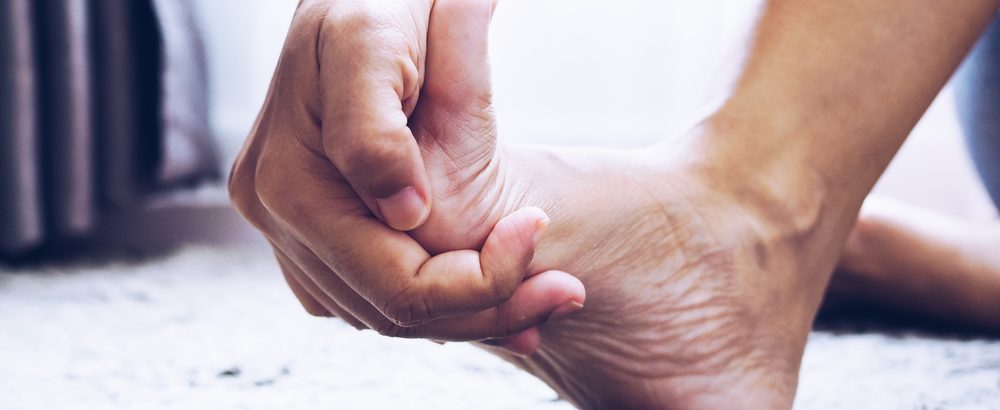What are Some Nonsurgical Options for Plantar Fasciitis?

Reviewing Your Noninvasive Options for Pain Relief
Our feet already endure daily wear and tear while performing daily activities such as walking, running, and jumping. It should come as no surprise that some people may develop plantar fasciitis, which occurs when the plantar fascia ligament in your foot becomes inflamed and causes sharp, stabbing heel pains. While most cases resolve within a year with or without treatment, there are a few nonsurgical treatment options that you can use to relieve the pain.
Stretching
Stretching is an essential part of any plantar fasciitis treatment. Tight muscles in your calves and foot arches can make symptoms worse, but you can soothe or prevent the pain by performing a few easy lower body stretches. Calf stretches target the gastrocnemius muscle, which is located on the back portion of your lower leg, and arch stretches stretch the middle of your foot.
You can stretch your calves by standing an arm’s length from a wall, placing your right foot behind your left, and then slowly and gently bend your left leg forward. As you lean forward, keep your right knee steady and your right heel planted firmly on the ground. Hold the stretched position for at least 15 seconds and release before reversing the position of your legs. Repeat each side three times.
To stretch your arches, you can perform a few seated stretching exercises. One easy movement is to roll your foot back and forth over a foam roller or frozen beverage bottle for one minute per foot before crossing one leg over the other and grabbing your big toe, gently putting it toward you for 30 seconds. Repeat three times per foot.
Alternatively, you can place a resistance band or folded towel under both of your arches and gently pull the tops of your feet toward you, holding for 15 to 30 seconds for three repetitions.
Pain Relief Medication
In addition to techniques such as ice massages, over-the-counter pain relievers are one option for reducing pain and discomfort caused by plantar fasciitis. Nonsteroidal anti-inflammatory drugs such as ibuprofen, aspirin, or acetaminophen are all popular options for controlling the pain.
Alternatively, if your symptoms are severe enough to impact your quality of life, you may consider corticosteroid injections in the tissues near your heel bone, which can provide rapid pain relief that may last for weeks. For long-term pain relief, botulinum toxin injections can relieve pain for months. It is important to note that though corticosteroid injections can interfere with the healing process, botulinum toxin injections do not.
Physical Therapy
Research shows that customized physical therapy programs can be a highly effective treatment option for plantar fasciitis. Treatment can include ice applications and strengthening exercises that can improve walking and significantly reduce pain. Heel raises, ankle inversions, and plantar fascia stretches are examples of standard physical therapy exercises that you can do at home and in therapy.
Night Splints
Night splints stretch your calves and foot arches while you’re sleeping, which can help lower heel pain first thing in the morning. Additionally, taping your foot can support your arch, reduce strain, and correct overpronation throughout your day.
Orthotic Shoe Inserts
Orthotic shoe inserts can help restore natural gait with arch support and heel cups. Inserts also help distribute pressure evenly when you are walking or running, reducing the stress on your plantar fascia.
Compression Socks
Compression socks are one effective option for treating plantar fasciitis, which puts mild to moderate pressure on your heel and provides arch support. Compression socks are available in multiple styles, including ankle or knee-highs, which can also compress your calves, as well as numerous uses. For instance, certain brands are better suited for athletic activity, while others are more viable for long periods of standing.
Supportive Footwear
Patients with plantar fasciitis often require supportive footwear for achieving maximum comfort during physical activity. While there is no “one-size-fits-all” solution when it comes to footwear, there are many options available to choose from in running shoes, walking shoes, hiking shoes, and sandals.
Losing Weight
Obesity or excess body weight is a considerable risk factor in developing plantar fasciitis due to the added stress that extra weight puts on your plantar fascia. Losing weight can not only reduce any pressure on your feet but can also make you feel better about yourself all around.
For most cases, the standard treatment for plantar fasciitis is plenty of rest, stretching, pain relief medications, ice massages, orthotics, and low-impact exercises for strengthening your muscles and maintaining your weight. Chronic and deliberating cases may require more extensive nonsurgical treatment options, such as injections or regenerative medicine.
Get Plantar Fasciitis Treatment in Maryland
If you are in Maryland looking for Plantar Fasciitis treatment, make an appointment with us today.





